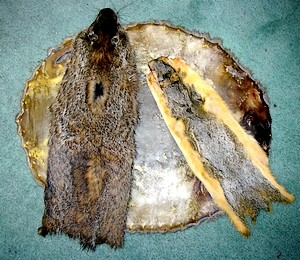 Us impressionists are a tough crowd, you’ll regret us painting your house because of all the spots we miss – but we’ll march you across the street and insist the color looks fine.
Us impressionists are a tough crowd, you’ll regret us painting your house because of all the spots we miss – but we’ll march you across the street and insist the color looks fine.
We’ve got more theories and hare-brained ideas than the average fly tyer, most won’t hold water so we wander around the fly shop sighing heavily, and then go home and make it ourselves.
Materials vendors don’t cater to guys that tinker, and that single-shade pack of rabbit would work well on a small dry fly, but we’re cooking up something with lead and multiple X’s of hook shank. Two bucks worth of bunny bottom just don’t cut it, and while the Australian Opossum was close to the right color, we could’ve snorted that microdot of hair and not sneezed.
For us, 2 x 2″ is an appetizer, and at those prices an expensive one.
I was taught that a good dubbing is crafted like a fine cigar; comprised of filler, binder, and wrapper, special effects can be added after the dubbing is complete, but the basic recipe is identical to a good smoke.
There’s an art form to winding up with what you intended to make; almost everything you construct will have some usefulness – but the thinking and planning are relatively easy – execution takes a little practice.
You’ve got only three obstacles, texture, color, and target application. I started with a couple colors of wool yarn, tossing in a hint of this and a dab of that – then when I’d stumbled onto something good – found I could never make it again.
Jotting down some recipe notes is required – some units of measure would be nice too. Square inches of hide comes to mind, as in, “I clipped four square inches of coyote, added four square inches of green mink, and dipped the result in my coffee – accidentally.”
That’s enough to get close.
With my blends I’ve learned to target a hook size with the completed product. The precise mix of filler, wrapper, binder and special effects changes depending on whether you’re crafting dry fly dubbing, a general nymph blend, or something for making giant stonefly nymphs. My General use blends target a #12 hook, dry fly blends I’ll target a #16, and for big stuff, I’ll want a long shank #4.
The above rule isn’t hard and fast, it’s my personal preference – this allows general purpose blends to work with dry flies as well as nymphs.
Once comfortable with mixing and colors, use Coffin Creek Furs to score the skins you need. Always opt for the damaged ones as they’re the cheapest and you’ll be shaving it anyways.
Be forewarned that real hides from a furrier can be a really good deal. Beaver is sold as “rounds” – the skin is stretched to a circle, a 20″ round that’s damaged may only be $10.00. That’s an “extra large Pizza” worth of Beaver – and will make you reticent to pay $2.50 for the little dust motes sold by the fly shop…
Filler: The filler is comprised of inexpensive coarser hair – it may contain guard hair, but is usually typified by “curly” fur fiber. These bends and kinks will be preserved in the final product and will add air and mass to the blended furs so it resists matting.
Example: Australian Opossum, Mohair, Wool,
Binder: The binder is usually a semi-aquatic mammal. Their fur has the smallest filament size and is quite dense, it assists them to remain warm despite constant exposure to cold water. The binder will coat the filler and wrapper and assist your fingers when you want that mess on your thread. Binder is your friend and can tame the most unruly fur.
Example: Beaver, Mink, Muskrat, Otter, (if nothing else is available, rabbit)
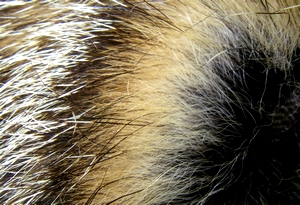 Wrapper: Wrapper is present on blends for larger flies and can be omitted for building fine dry fly dubbing. Wrapper is usually an animal that has pronounced guard hairs – often with a light band that can absorb dye. It provides “spike” to the blend and breaks up the uniformity of the other two furs.
Wrapper: Wrapper is present on blends for larger flies and can be omitted for building fine dry fly dubbing. Wrapper is usually an animal that has pronounced guard hairs – often with a light band that can absorb dye. It provides “spike” to the blend and breaks up the uniformity of the other two furs.
Just as important, because we choose it for the guard hair, we’re introducing six or seven new shades to the blend. If you’re going to dye the result those shades will break up the even color and add light and dark splotches within the mix.
Example: Hare’s Mask, Red Fox Squirrel body, Woodchuck body
Special Effects: Special effects describe any enhancements added like glitter, shine, or contrasting color. Materials chosen impart an affect to the entire mix like spectrum or sparkle.
My use of sparkle increased with proximity to Brownline prey. The waters are often milky with effluent during peak farming periods – and coupled with Winter drainage I have to help fish see my offering.
That’s translated well to trout fishing, as I’ve found the pedigreed blue water fish like a hint of sparkle in their food too. Usually the special effect component is less than 10% of the final blend.
Example: Baby Seal, Soft Crimp Angelina (Ice Dub), and Spectral
Spectral is the color combination of the primary and secondary colors of the color wheel; scarlet, yellow, cyan, orange, purple, green.
Use a coffee grinder (maybe $15) to blend colors and fur, most of the fur you’ll be using is less than an inch in length and won’t bind the grinder motor. Lacking a grinder, use a empty quart jam jar half filled with water – shaken vigorously it’ll mix hair in seconds.
If your fur source is fresh killed or road kill, toss in some shampoo to remove guts, blood, and tire marks. Repeat with clean water to rinse. Large batches are best mixed with a big container or a garbage bag.
Smaller hooks need more binder (the really fine fur), general use blends are roughly an equal mix, and the large hooks require more filler and wrapper. The completed mix shouldn’t require the tyer to load the thread more than twice to finish the fly body, and if you find yourself adding more than a couple applications of fur – your blend is best suited for a smaller hook.
The indispensable materials are Beaver and Red Fox Squirrel body, both are dirt cheap and plentiful. You’ll get additional use if your source has the Squirrel body in tanned flavor – as it makes the stunning fur strip leeches – the bands of color makes the rabbit versions look limp in comparison.
Adapt, evolve, and overcome – free yourself of what’s on the retailer’s shelf and make what you really need, just remember to clean the kitchen spotless – or it’s your hide we’ll be admiring.
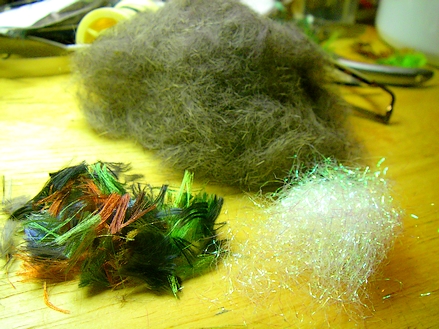
Above is a general purpose blend of Australian Opossum, Red Fox squirrel body, and dark gray beaver. In it’s present form it’s useful for both dry flies and nymphs. I’ll add chopped polyamide “clownshoes” colors – leftover from the streamers I tied for a spectral color effect, and add about 5% sparkle to the blend using Soft Crimp Angelina, in the opalescent “Aurora Borealis” color.
The Polyamide fibers are tiny – half the width of a beaver fiber, so the spectral affect will not be pronounced, it’ll still look like a gray blend until I dub the flies where a close examination should make colors show more plainly.
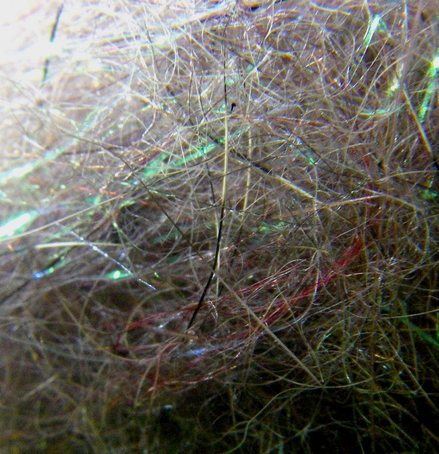
A close up of the finished blend; three natural furs, polyamide, and Soft Crimp Angelina. The polyamide fibers offer a very subtle color effect.
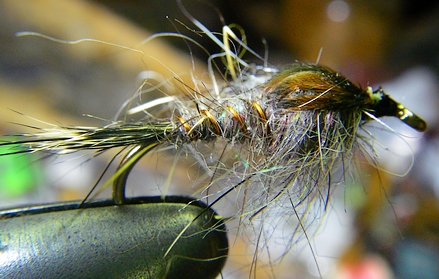
… and a #12 Copper Ribbed Hare’s Ear tied with the mixture. I touched the thorax up with Velcro to add some additional scruffiness.
Total preparation time for the fur blend was five minutes, resulting in about ½ ounce of this color. That’s a ball as big around as your clenched fist – and should tie a couple hundred dozen trout flies.


Probably your best post ever on DIY tactics. You should thumbtack this post to the top of your page.
Well done my good man.
have you found a good place to get your “Soft Crimp Angelina”?
Soft Crimp Angelina is still not commercially available save going direct to the company. Unless it’s a color they have on hand – it’s a 10 lb minimum order. ( ~$500)
You can find the links to the vendor on this site, Meadowbrook Glitter Co – just search for Angelina.
..either that or we get a bunch of guys that want some and I can place a 10 lb order …
zac,
If you drop me a line via email, I’ll grab a hank of what I have and send it to you. I’ll check whether they’re making it at the moment.
Great stuff Keith, although I’ve gotta disagree with your title. I used the food processor once and nearly ended up single for it.
Your wife objected to the “Furrpacchino?”
That’s magic stuff, it doesn’t matter how clean you think the grinder is – the next cup of coffee made is mustache material..
I bought my own – after nearly being dismembered by flying cutlery and harsh language.
I should always add the disclaimer: I am the cook for my family, if you’re not – don’t try this at home. I can get out of the doghouse by the next meal, most of my readership cannot.
Keith, I would like to buy a bag of that blend, can I get some?
Perhaps you could give some to your dad to bring some for me at the duck show?
Cheers,
Pingback: » Odds and Ends from Friends Today…. Best Fly Fishing Yellowstone.com: Flyfishing in Yellowstone, Montana, and Around
Maurice,
No problem, drop me a note with your address. You want some of the blend shown above?
I’ll be making a couple varieties, happy to throw some of that in an envelope as well.
That would be cool, Troon is calling your dad to get me your phone number and/or address. Looking forward to having a chance to chat.
Cheers again,
MH
Missed day tripper, glad to find this from a referrer to my site, great article, I dont own a grinder or proper blender but the habd held blender doesn’t work believe me, stuff flies all over.
Ian (naisreka)
Pingback: do it yourself dubbing material | Willfishforwork.com
Pingback: Dubbing « Flyfishing Flytying Journal
Pingback: Blending Fur (A new Coffee Grinder for the Wife) « SwittersB & Fly Fishing
That fly looks awesome. It’s making me hungry!
Pingback: 40 Rivers To Freedom » Blog Archive » How To Make Your Own Dubbing
Not sure how I missed this! Neat stuff, but what do you do if you don’t have grinder since your wife doesn’t drink coffee. Trying to blend this stuff by hand is be a drag and PITA.
I’ve always hated buying those 2×2 bags of not quite the color or blend I’m looking for.
I guess I need to put a grinderr on my birthday list.
you can buy a grinder for $20. best money ever spent
Doug,
Use a quart mayonnaise jar half filled with water. It’ll slow you down a bit because the fur has to dry before use – but a vigourous shake will blend the fur really nicely.
When the fur dries it will be felt. It’ll be matted down in a compact and dense manner. You’ll need to pull it apart to return it back to the lighter fluffy stuff – but it’ll still work.
I actually use both methods – unfortunately to return the “felt” to loose fur, I’ll use the coffee grinder – it’s much simpler to add air that way.
Coffee grinders are $15 at most stores. Always remember to cut the filaments short if you’re using yarn or mohair – about 1.5″ is all you can go … otherwise the fibers wrap around the center spindle of the grinder and will have to be cut free.
Feel free to contact me if you need assistance.
Man am I sure glad I don’t have this “wife” figure you all speak of. I do have a grinder though.Great post.
I use a butter dish to mix my dubbing. You drill very small holes in the lid so that it has holes like the face of a clock. you drill a slightly larger hole in the center. In the center hole you insert a straw, I tape mine in place. All you have to do then is put the fur in the plastic margarine tub, put the lid on top, and blow into the straw. It creates a cyclone effect inside the plastic butter tub thus mixing your dubbing. WARNING…Do not suck. Fur does not taste good. You can also trade the straw out for an old aquarium air pump and tubing if you do not want to blow into the dish constantly. Good luck, and happy fishing to all.
Pingback: Big on Yarn but even bigger on frugal | Singlebarbed
Pingback: Anatomy of a spectral blend | Singlebarbed
Another option for fur is http://www.moscowhideandfur.com ALOT of fur option both raw and tanned. They have feathers and other things as well. They have a small order handling fee if you order under $30. But I have never had a problem finding at least $30 worth of stuff. They also have australian possum.
Good article 1. I need more guidance on the proportion of filler, to binder to wrapper 2. More explicit directions on the use of the coffee bean blender, how long, how many times , how much material to load into the mix each time, is there a sequence of what is added if multiple spin sessions are used ?
Baxter,
The proportions of filler, binder, and wrapper may differ based on what kind of dubbing you’re making. A heavy coarse fur for big stonefly nymphs would be a different proportion of the three than a blend for small nymphs.
Binder = increase when you wish blends for small flies or smooth flies
Filler = increase for medium sized flies or to make a short haired nap (fuzzy fly)
Wrapper = increase for big flies and when you want gaurd hairs sticking out all over.
2) The blender is done visually. Remove the fur and inspect until happy. I typically like incomplete blends as it leaves small bits of color in the result.
You can only blend what will spin. If you fur is not spinning freely in the grinder then it’s not mixing.
Yes, There may be a sequence when you’re mixing colors of fur. Mix the colors first to achieve the finished color, then add all other components.
Pingback: What Materials do you use to make Dubbing - Page 2 - The North American Fly Fishing Forum